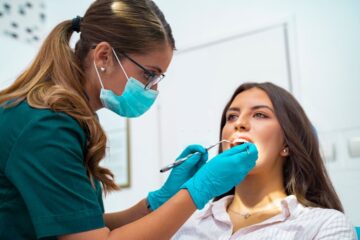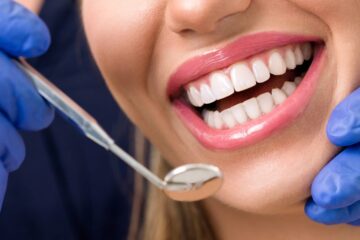Did you know that over 4 million people in the United States wear braces?
If you are considering getting braces, this guide is here to help you every step of the way. From understanding the different types of braces to caring for your teeth and braces, we will provide you with all the information you need before, during, and after your treatment.
Let’s get started on your journey to a beautiful and healthy smile!
Understanding the Different Types of Braces
When considering braces, you should familiarise yourself with the options available to you. Understanding the different types of brackets and clear aligners can help you make an informed decision about which type of braces is best for you.
Types of brackets play a significant role in orthodontic treatment. Traditional metal brackets are the most common type and are known for their durability and affordability. Ceramic brackets are a more aesthetically pleasing option, as they blend in with the natural colour of your teeth. Another type of bracket is the self-ligating bracket, which doesn’t require elastic or metal ties and can reduce treatment time.
Clear aligners are an alternative to traditional braces. They’re virtually invisible and can be removed for eating and oral hygiene. Clear aligners use a series of custom-made, removable trays to gradually align your teeth. This option is popular among adults and teenagers who desire a more discreet orthodontic treatment.
Before deciding on the type of braces, consult with an orthodontist who can assess your needs and provide recommendations based on your specific case. They can guide you in choosing the most suitable option for achieving a straighter and healthier smile.
Preparing for Braces: What to Expect Before Treatment
Before getting braces, you should schedule a consultation with your orthodontist to discuss the treatment plan and any necessary preparations. This initial appointment is essential to set your expectations and ensure a smooth process. During the consultation, your orthodontist will evaluate your teeth and jaw, take X-rays, and discuss the specific treatment options available to you. They’ll also address any concerns you may have and provide detailed information about what to expect before, during, and after treatment.
Once you have decided to proceed with braces, your orthodontist will guide you on how to prepare for the treatment. This may include getting any necessary dental work done, such as fillings or extractions, to ensure your teeth are in the best condition possible. They may also recommend certain adjustments to your oral hygiene routine, such as using a fluoride mouthwash or a special toothbrush, to maintain good oral health throughout the treatment process.
It’s important to understand that getting braces can cause discomfort initially. You may experience soreness and sensitivity in your teeth and gums as they adjust to the braces. Your orthodontist will provide you with tips and techniques to manage this discomfort, such as using over-the-counter pain relievers, rinsing with warm salt water, or using orthodontic wax to alleviate any irritation from the braces.
The Braces Journey: What Happens During Treatment
During treatment, you’ll visit your orthodontist regularly for adjustments and check-ups. These visits are crucial for the success of your braces journey. Here’s what you can expect during this phase:
– Adjustment Process: At each visit, your orthodontist will make adjustments to your braces by tightening or replacing the wires. This process helps to gradually shift your teeth into their desired positions. You may experience some discomfort or pressure after each adjustment, but this is perfectly normal and a sign that your braces are working.
– Monitoring Progress: Your orthodontist will closely monitor the progress of your treatment during each visit. They’ll check the alignment of your teeth, evaluate the movement, and make any necessary adjustments to ensure the treatment is on track. Regular check-ups allow them to address any issues or concerns that may arise.
– Common Challenges: Throughout your braces journey, you may encounter some common challenges such as soreness, difficulty chewing, or speech changes. These challenges are temporary and can be managed with proper care and patience. Your orthodontist will provide you with tips and guidelines on how to alleviate any discomfort and maintain good oral hygiene.
Caring for Your Teeth and Braces: Tips for Proper Oral Hygiene
To maintain good oral hygiene while wearing braces, you should be mindful of the food you eat and avoid hard or sticky foods. These types of foods can easily get stuck in your braces, making it difficult to clean properly and increasing the risk of tooth decay.
In addition to being cautious about your food choices, it’s important to establish a daily oral hygiene routine that includes proper brushing techniques and flossing with braces.
When it comes to brushing your teeth with braces, it’s recommended to use a soft-bristle toothbrush and fluoride toothpaste. Start by angling the toothbrush at a 45-degree angle towards the gumline and gently brush in small circular motions. Be sure to clean all surfaces of your teeth, including the front, back, and chewing surfaces. Pay extra attention to the areas around the brackets and wires, as these areas tend to collect food particles and plaque.
Flossing with braces can be a bit more challenging, but it’s still essential for maintaining good oral health. Use a floss threader or orthodontic flosser to easily navigate the floss under the wires and between the teeth. Gently slide the floss up and down, making sure to clean both sides of each tooth. Don’t forget to floss between each tooth and behind the back molars.
In addition to brushing and flossing, it’s also important to rinse your mouth with an antimicrobial mouthwash to help kill bacteria and freshen your breath. Remember to visit your orthodontist regularly for check-ups and professional cleanings to ensure that your teeth and braces stay in good condition throughout your treatment.
Life After Braces: Maintaining Your New Smile
How can you ensure that your new smile stays beautiful and healthy after braces? Taking care of your teeth and maintaining the results of your orthodontic treatment is crucial. Here are some retention tips to help you maintain your new smile:
– Wear your retainer as directed: After your braces are removed, your orthodontist will provide you with a retainer. It’s essential to wear it as instructed, whether it’s full-time or just at night. Your retainer will help keep your teeth in their new positions and prevent them from shifting back.
– Practice good oral hygiene: Continue to brush your teeth at least twice a day and floss daily. Maintaining good oral hygiene is essential to prevent plaque buildup and tooth decay. Be sure to clean your retainer regularly as well, following your orthodontist’s instructions.
– Visit your orthodontist regularly: Schedule regular follow-up appointments with your orthodontist to monitor the progress of your treatment and ensure that your teeth remain in the desired position. Your orthodontist may make adjustments to your retainer or recommend other orthodontic appliances if necessary.
Frequently Asked Questions
Will Getting Braces Hurt?
Getting braces may cause some discomfort, but pain management techniques can help alleviate it. Your orthodontist will provide guidance on how to manage any pain or discomfort you may experience during the treatment process.
How Long Does the Process of Getting Braces Take?
The process of getting braces generally takes a few steps and can vary in duration depending on individual circumstances. It’s important to consult with your orthodontist for an accurate timeline and to discuss any concerns you may have.
Can I Still Play Sports or Musical Instruments With Braces?
Yes, you can still play sports and musical instruments with braces. While there may be an adjustment period, proper protection and technique can help you continue enjoying your activities without any major issues.
Are There Any Dietary Restrictions During Braces Treatment?
During braces treatment, you will have some dietary restrictions. Certain foods, like sticky candies and popcorn, should be avoided to prevent damage to your braces. However, there are still plenty of food choices available to enjoy.
What Are the Potential Risks or Complications Associated With Braces?
The potential risks and complications of braces include tooth decay, gum disease, and root resorption. It is important to maintain good oral hygiene, attend regular check-ups, and follow your orthodontist’s instructions to minimise these risks.
Conclusion
In conclusion, getting braces is a journey that requires preparation, commitment, and proper oral hygiene. Did you know that approximately 4 million people in the United States wear braces? This statistic highlights the commonality of this orthodontic treatment, emphasising that you aren’t alone in your journey to a beautiful smile.
Remember to follow your orthodontist’s instructions and maintain good oral hygiene to ensure the best results. Your new smile awaits!





